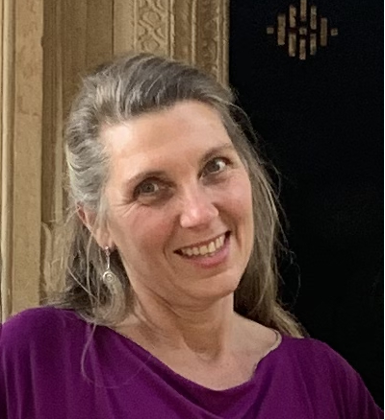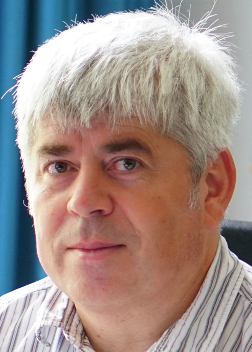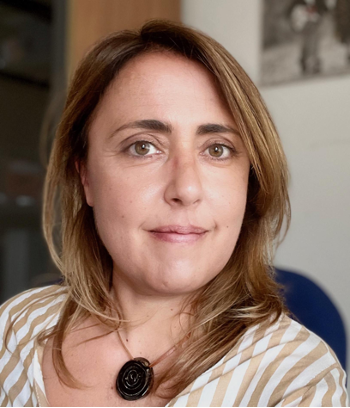
Interviews to experts to gather evidence for the Policy Round Table
- Dunia Mladenic, J. Stefan Institute
- Franz Rottensteiner, LUH
- Valeria Seidita, UNIPA

Nationality: Slovenia | Institution: J. Stefan Institute| Expertise:
Artificial Intelligence, Text Analysis, Machine Learning, Semantic Technologies | Relationship to SILKNOW: Partner
Q1: After the experience of the pandemic, what have we learned about the need for digital transformation, especially in relation to cultural heritage?
A1: Digital transformation may be a big enabler connecting people and providing access to knowledge and resources crucial for contemporary lifestyle.
Q2: What are the advantages of open data and the semantic web in relation to cultural heritage? And the ways of having access to them (e.g. interaction paradigms, multimodality)?
A2: They enable simple exchange of data, combining & accessing different data sources in a generally usable user-friendly way.
Q3: In the case that you are dealing with aspects related to artificial intelligence, do you think the current European regulations are enough? Would something else be needed?
A3: European regulations are a good step to help society in safe usage of AI. However, we need to consider different stakeholders, take care of ensuring the flow of creative innovation, provide an understandable description of AI systems for policy makers and informed public.
Q4: As experts in technologies related to digital transformation, what do you need, besides money, to better respond to current demands (e.g. open data, interoperability)?
A4: Open data and transparency of policy measures, as we need to plan in advance which research directions to put on priority .
Q5: What do you expect from European programs to better support your work? There are calls and funding opportunities, but they are very competitive, and with unpredictable results. In what other ways could the EU reach out to you, how can they better support you?
A5: Simplified process for embarking on funding opportunities and minimal administrative/reporting formalities. Longer project duration to enable achieving more results and provide stability for the engaged researchers and students.
Q6: What would you ask to policymakers (not only for the EC, also for regional governments).
A6: Use the available technology to observe the reality of the world in which we live, connect and use the available data to understand the needs of the society also in the future as provided by predicting and what-if scenarios, support SME in innovative activities and collaboration with research organizations.
Q7: Any other comment you consider relevant
A7: The reality in which we live is highly dynamic and requires great flexibility also in policy measures, requiring to look beyond the known and usual, engagement of different stakeholders and trust in creative forces of the forthcoming generations.

Nationality: Austrian | Institution: LUH| Expertise:
Photogrammetry, Machine Learning, Artificial Intelligence | Relationship to SILKNOW: Partner
Q1: In the case that you are dealing with aspects related to artificial intelligence, do you think the current European regulations are enough? Would something else be needed?
A1: I am not really familiar with the European regulations about artificial intelligence. I see it as a tool that offers many opportunities, but there are also some very serious ethical problems, at least in open societies such as the one the European Union should strive to be. Developments such as those related to surveillance in China are examples for what the EU should not only try to avoid, but prohibit. At the same time, it might be a good idea to revisit or at least discuss some regulations that, at the current time, make the application of the best available algorithms (deep learning) impossible in some industries.
Q2: As experts in technologies related to digital transformation, what do you need, besides money, to better respond to current demands (e.g. open data, interoperability)?
A2: The availability of data for research purposes is certainly an important aspect. Modern AI methods require lots of training samples to be able to achieve good results, and getting such data is expensive.
Q3: What do you expect from European programs to better support your work? There are calls and funding opportunities, but they are very competitive, and with unpredictable results. In what other ways could the EU reach out to you, how can they better support you?
A3: Reduce the amount of bureaucracy required for everything, e.g. for managing grants or for exchange of researchers (for instance, in principle I need to prove I am insured in Germany whenever I go abroad, even for a conference, and I have to apply for this proof every time from scratch).
Q4: What would you ask to policymakers (not only for the EC, also for regional governments).
A4: Currently we heavily rely on development frameworks and annotated datasets for training that are provided to the scientific community by a few big US companies (e.g. Google, Facebook). I sometimes wonder whether this is a healthy development from the point of view of Europe. Perhaps the Europeans should try to build some counter-weight to reduce their dependence on external resources.

Nationality: Italian | Institution: University of Palermo | Expertise:
Software engineering, multi-agent systems, autonomous and adaptive systems, human-robot teaming interaction | Relationship to SILKNOW: Partner
Q1: After the experience of the pandemic, what have we learned about the need for digital transformation, especially in relation to cultural heritage?
A1: In general, digital transformation is a virtuous process that uses digital technologies to make large amounts of resources available in a completely inclusive way. The pandemic has highlighted the need for a global digital transformation because of the isolation that still persists. While before we could think of focusing on economic or business areas, for example with the dematerialization of paper documents, now, after the pandemic, we can think of applying and promoting this concept to the field of culture in general. Today, more than ever, digital transformation must target all those areas that provide services of any kind to people and ensure effective and informed access.
Q2: What are the advantages of open data and the semantic web in relation to cultural heritage? And the ways of having access to them (e.g. interaction paradigms, multimodality)?
A2: The concept of heritage, of whatever kind, is, in my opinion, closely connected with the concept of fruition and therefore the answer to this question lies in the question itself. The advantage of open data is that it is open and therefore accessible to all. The semantic web is the ideal tool to make the use of cultural heritage more efficient. The idea that I can research a particular topic using an application that automatically correlates documents and information in a way that is just profiled for my work or interests, or that I can navigate through a historical site using virtual reality, for example, making goods and resources accessible even from distant places or for people with disabilities, is something really attractive.
Q3: In the case that you are dealing with aspects related to artificial intelligence, do you think the current European regulations are enough? Would something else be needed?
A3: I am not an expert on European regulations, but from my small experience of project presentations, both national and international, I find that excessive attention is paid to data protection, often resulting in being stuck in long and boring bureaucratic procedures. It is not that data protection is not important and should not be ensured, but perhaps, given that digital transformation inevitably uses technologies that process data, we should think about more streamlined procedures and regulations that do not leave any ideas blocked.
Q4: What do you expect from European programs to better support your work? There are calls and funding opportunities, but they are very competitive, and with unpredictable results. In what other ways could the EU reach out to you, how can they better support you?
A4:Yes, it is true that there are many calls for proposals and grants, but one gets the impression that the machinery of project submission is so elephantine that it can only be handled by very large and strong research groups that also have large and very competent administrations behind them. Perhaps the whole project submission phase could be streamlined, perhaps by breaking it down into several steps and using smaller resources, so that it can also be managed by small groups or individuals.
Pierre Vernus
Nationality: French| Institution: Université Lumière Lyon 2 | Expertise: Silk industries history, economic and social history, digital history. | Relationship to SILKNOW: Partner
Q1: After the experience of the pandemic, what have we learned about the need for digital transformation, especially in relation to cultural heritage?
A1: It is not obvious that the pandemic of COVID 19 will lead to a fundamental change in the framework of reflection that should guide digitization of cultural heritage: why and for whom digitize? And consequently what to digitize?
On the other hand, it engages to develop new tools allowing to diversify and to widen the access to the collections in virtual form to wider categories of the population while taking into account the fact that a significant part of this population does not necessarily have the skills or the digital equipment allowing to benefit from these new tools. Indeed, COVID-19 revealed or rather reminded us that there are inequalities in accessing digital technology, which tend to be underestimated. It is therefore necessary to ensure that digitization projects in the field of cultural heritage are not socially discriminating, which would go against an inclusive society.
Q2: What are the advantages of open data and the semantic web in relation to cultural heritage? And the ways of having access to them (e.g. interaction paradigms, multimodality)?
A2: Open data and semantic web offer great potential. The open data movement allows the sharing, exchange, reuse and enrichment of data. Producing opendata requires an in-depth reflection on the licenses to adopt according to the nature of the data sets made available. Linked data and the semantic web promote the interoperability of data and the possibility of developing new knowledge.They also contribute to making the traditional boundaries between professional sectors such as humanities and social sciences researchers, librarians, archivists or museum curators more permeable and to fostering common reflection and collaborations around the issue of production, structuring and use of the data they produce.
Q3: In the case that you are dealing with aspects related to artificial intelligence, do you think the current European regulations are enough? Would something else be needed?
A3: I am not an expert of European regulations on AI.
Q4: As experts in technologies related to digital transformation, what do you need, besides money, to better respond to current demands (e.g. open data, interoperability)?
A4: The digital transformation, the sharing and the interoperability of data require infrastructures that allow easy access to these data and their preservation. Encouragement and aid to facilitate the implementation and maintenance of such infrastructures are essential, especially since the projects are financed for a limited period of time and the solutions that allow for the maintenance of tools and their long-term sustainability are not always easy. Furthermore, it is necessary to encourage the implementation of platforms and the definition of workflows that facilitate the transformation of old data sets into FAIR data sets. Finally, it is important to encourage the work of communities of domain experts who are thinking about the development of shared data models or repositories in order to promote interoperability and the exchange of research data.
Q5: What do you expect from European programs to better support your work? There are calls and funding opportunities, but they are very competitive, and with unpredictable results. In what other ways could the EU reach out to you, how can they better support you?
A5: Simplify the procedures for proposals to calls and managing projects. Propose more generic calls in order to encourage the emergence of new research orientations. Favour longer-term funding to give more stability and long-term visibility to researchers involved in a project: research often needs more than three or four years to explore possible avenues and achieve solid results.
Q6: What would you ask to policymakers (not only for the EC, also for regional governments).
A6: The preparation of responses to calls for projects is extremely complex, the financial and administrative requirements are very time-consuming, and are partly to the detriment of the researchers’ research work and have led to the setting up of services dedicated to them. A study aimed at identifying and evaluating all the global costs, visible and hidden, linked to the setting up, management and control of projects would be necessary in order to know, on objective bases, if the current modalities of resource allocation in the field of research are really optimal. This is all the more justified since these costs are borne by the community.